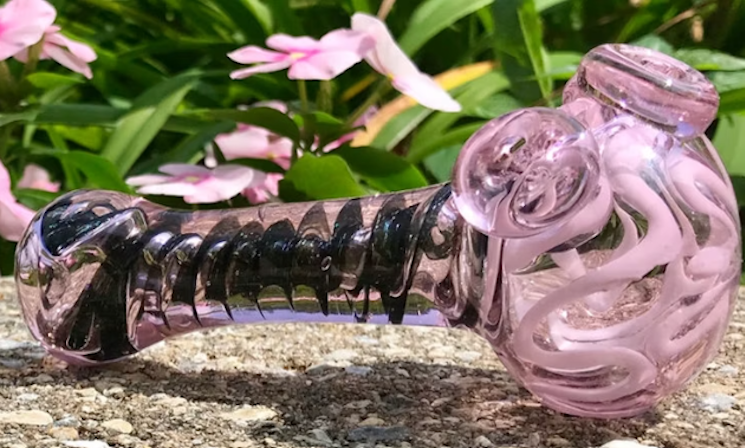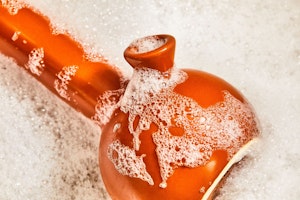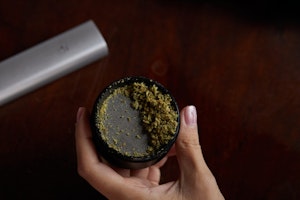
RDNE Stock / Unsplash
You deserve the smoothest smoke, and the key to that is regular pipe maintenance.
With just a few simple materials, you can keep your pipe sparkling clean. But cleaning your pipe is about more than just keeping it looking good—it’s crucial for maintaining the taste, quality, and purity of your smoke.
Is It Important To Clean A Weed Pipe

Absolutely, cleaning your weed pipe is essential.
Regular cleaning prevents the buildup of potentially harmful residues such as tar, mold, bacteria, and fungi. When you light up a dirty pipe, these substances can be reheated and inhaled, posing significant health risks.
For instance, inhaling mold can lead to respiratory issues, allergic reactions, and in severe cases, infections such as bronchitis or lung infections. Tar and other combustion byproducts can contribute to chronic bronchitis and have been linked to a higher risk of lung cancer.
Cleaning also prevents your pipe from getting clogged, maintains good airflow for smoother smoke, and extends its lifespan overall.
How To Clean A Pipe: 2 Methods

PHOTO BY FAT BUDDHA GLASS
Glass, Metal, Ceramic Pipes: Isopropyl Alcohol & Salt
This method is one of the most mainstream and effective ways to clean a glass, metal, or ceramic smoking pipe.
Supplies Needed:
Isopropyl alcohol (preferably 90% or higher)
Coarse salt (sea salt or kosher salt works well)
Zip-top bag or a container with a lid
Cotton swabs or pipe cleaners
Paper towels
Steps:
Remove any movable parts from your pipe. Tap out any residual ash or debris from the bowl.
Place your pipe and any parts into a plastic bag or container that has a lid. Add enough isopropyl alcohol to submerge the pieces.
Add a tablespoon of coarse salt (this will help scrub off residue)
Seal the bag and shake for about 1-2 minutes. If using a container with a glass pipe, let it soak for 15-20 minutes.
Remove the pipe from the isopropyl alcohol solution and use cotton swabs or pipe cleaners to scrub any stubborn areas of residue off.
Rinse extremely well under water to remove any alcohol and salt traces. Dry with paper towels or let air dry completely before using.
Glass Or Metal Pipes: Boiling Water
For those who prefer not to use alcohol or want to save some extra dollars, boiling water can be an effective alternative for your glass or metal pipes.
Supplies Needed:
Large pot (enough to completely submerge your pipe)
Water
Tongs or a mesh strainer (to handle the hot pipe)
Steps:
Fill the pot with enough cold water to cover the pipe. Make sure the pipe is carefully submerged. It’s important to start your pipe in cold water to avoid cracking under heat shock, especially when cleaning glass pipes.
Bring your pipe and cold water to a boil.
Let the pipe simmer in the boiling water for about 10-15 minutes. The heat will loosen the resin and grime.
Carefully remove the pipe from the water with tongs. Use a pipe cleaner or cotton swab to remove any remaining residue while the pipe is still warm (be careful not to burn yourself).
Rinse the pipe under warm water. Dry thoroughly with a towel or let it air dry completely before using.
How To Clean A Wood Pipe

cottonbro studio / Unsplash
A gentler touch is needed for cleaning a wood pipe compared to other materials.
You want to avoid damaging the wood, so soaking in water or alcohol is a no-go. Only excessive build-up should be removed to avoid scraping the wood.
Supplies Needed:
Warm water
Soft cloth or sponge
Cotton swabs
Pipe cleaners
Mild dish soap (optional)
Small brush (like a toothbrush)
Olive oil or beeswax (to condition wood)
Steps:
Carefully disassemble the pipe if in parts.
Gently tap out any residual ash or debris from the bowl.
Dip a soft cloth or sponge in warm water (with some dish soap if preferred). Avoid soaking the cloth since excessive water can cause swelling and warping in the wood. Thoroughly wipe the exterior and interior surfaces of the pipe.
Use a small brush or cotton swabs to remove any buildup from hard-to-reach areas and the bowl carefully. Be gentle and avoid scratching the wood.
After cleaning, dry the pipe immediately with a clean, dry cloth. It’s important to make sure no moisture remains, since it can lead to mold or mildew.
Once completely dry, consider applying a small amount of oil like olive oil or beeswax to condition the wood and prevent it from drying out.
Herb Recommended Products:
READ MORE










